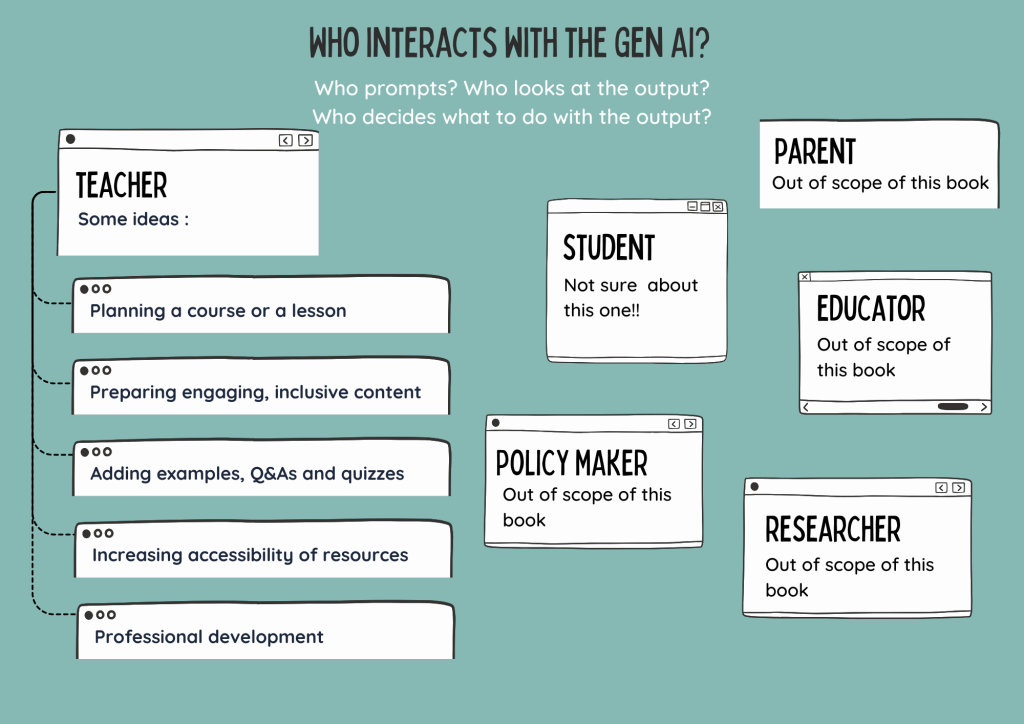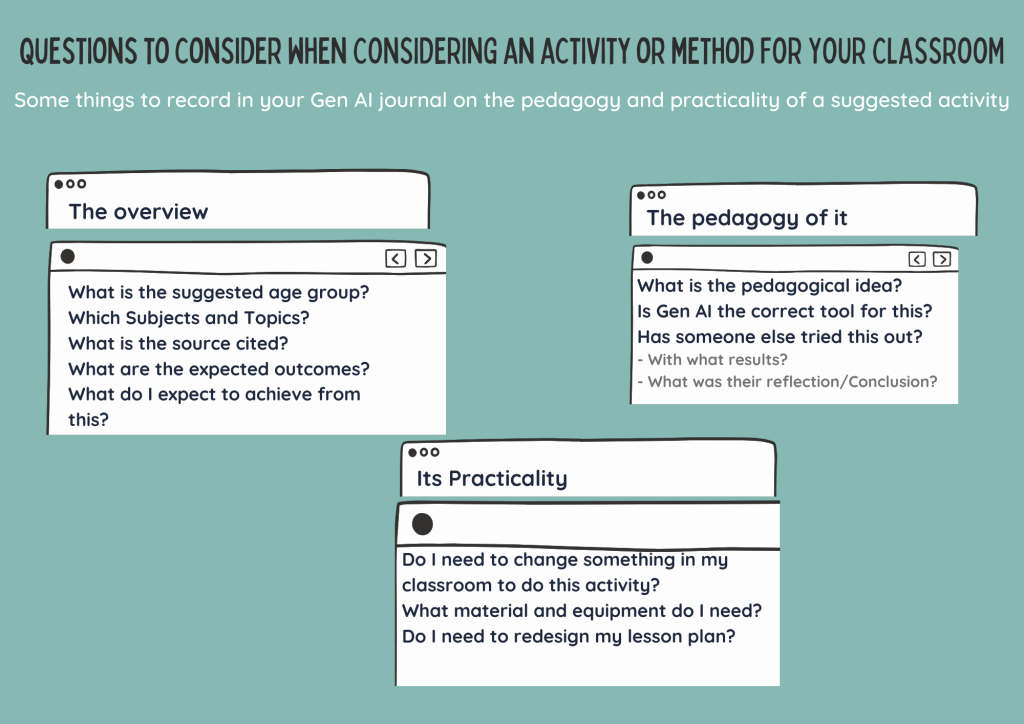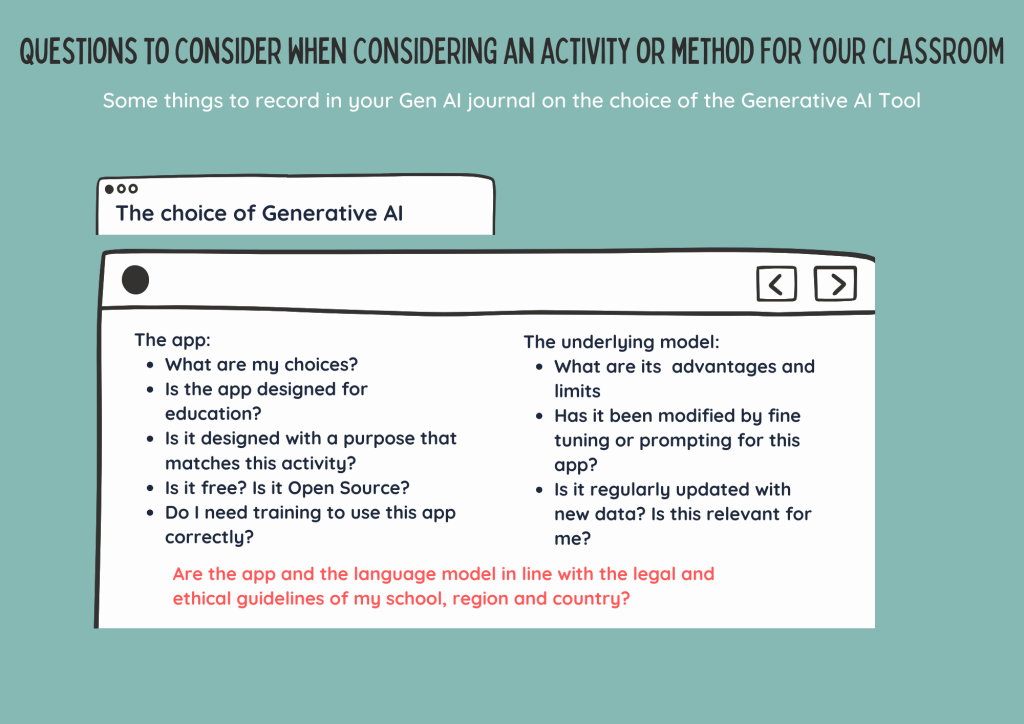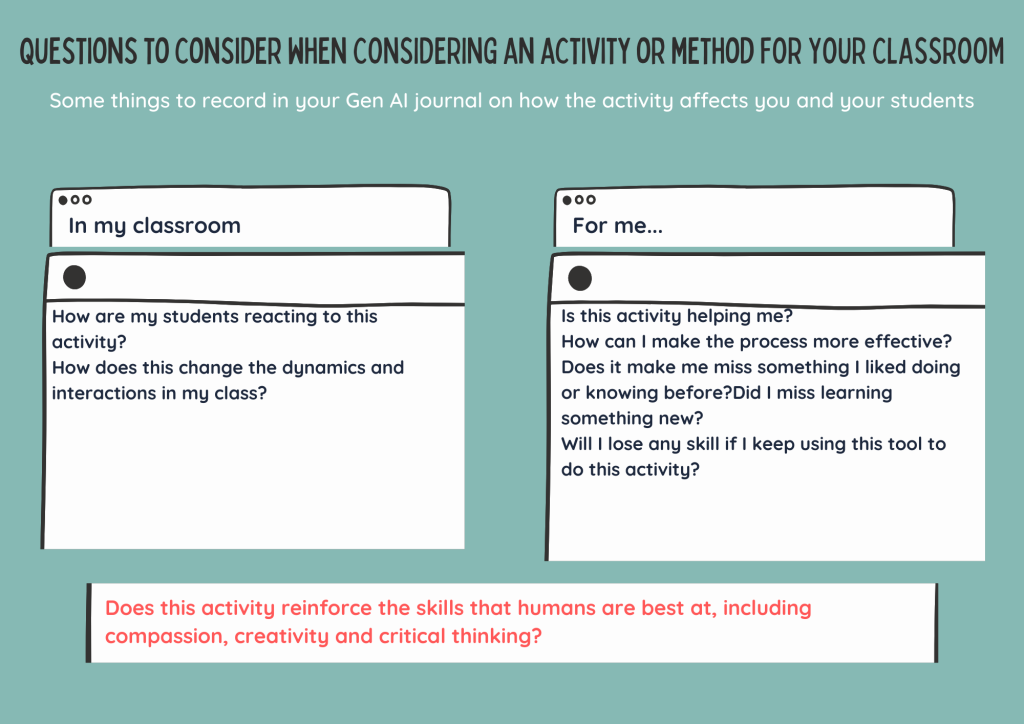On Generative AI
34 Generative AI for the Classroom, part 1
What do you do when someone suggests that you try out an activity using a generative AI tool? What do you do when you have an idea for an activity but are unsure about how to adapt it?
Here, the goal is to assist you in evaluating, choosing and carrying out such activities.
Due to the speed of evolution of this technology and given how performances change with subjects and contexts, all the questions a teacher need to ask cannot be listed in advance. We hope only to get you started in lines of thinking recommended by published guidelines and supported by research and case studies.
Please note that in this book we look only at those activities where the teacher, not the student, interacts with generative AI. Our reasons behind this are explained in the link provided in the box.

Even if you are not convinced that Gen AI tools should have a place in education, we urge you to try at least one activity that uses generative technology. It might help you:
- Understand what someone can and cannot do with the tools provided by generative AI;
- Reformulate or rearrange course elements, especially when deciding what can and cannot be given for homework. For example, ChatGPT can be effective in helping students write essays1 and it might be futile to assign standard essays for homework. You may have to use a variety of assessment methods such as group projects, hands-on activities and oral presentations, and go beyond simple yes or no questions1;
- Understand the limitations of this technology so you could use them to motivate students to apply themselves, their imagination and creativity2;
- Not feel left behind when the next generation of these technologies, with more advanced capabilities, become reality;
- Use them to reduce your workload and explore new topics which might have been too forbidding or time-consuming before;
- Take advantage of new schools of thought and approaches to learning that are now possible;
- Help shape research and development of educational applications of these tools3.
At the same time, given the novelty of the technology and methods, we strongly recommend that you record in a journal the particulars of any activity and its evolution. This will help you to monitor and evaluate the short-term and long-term effects of each activity and to discuss with your colleagues what you observed.
Questions on pedagogy and practice
Anyone can suggest an activity for the classroom. It might happen that they come from the world of technology and have little understanding of the classroom situation. Or, It might be an idea that works for a university student but not an adolescent. Even if the activity is suitable for your classroom, if it is not backed up by reliable pedagogical theory and classroom evidence, it might produce some surprises in the long term. Thus, we encourage you to approach any activity with questions on pedagogy and practicality.

Questions on the Generative AI
At the heart of a generative AI application is a large language model (LLM) or image model (diffusion model). As linguist Noam Chomsky put it, “Roughly speaking, they [large language models] take huge amounts of data, search for patterns in it and become increasingly proficient at generating statistically probable outputs, such as seemingly human-like language and thought4.” BERT, BLOOM, GPT, LLaMA and PaLM are all large language models. The corresponding deep-learning model for images is called a diffusion model. Stable diffusion and Midjourney are popular examples.
Either the parent company or a third party can take a LLM and further train it (fine tune it) for specific tasks such as responding to queries and summarising essays. Or, they might take a LLM or a chatbot, add a few prompts or do extensive programming and release the result as an application package (Chatpdf, Elicit, Compose AI, DreamStudio, NightCafe, PhotoSonic, Pictory).
OpenAI fine-tuned its GPT3 and GPT4, in order to produce ChatGPT. It used prompt-response samples and rules on acceptability of content. A Google Research team trained PaLM with scientific and mathematical data in order to get Minerva. This language model then achieved state-of-the-art results for a language-model application which solved quantitative reasoning problems. It was able to solve nearly a third of undergraduate-level problems in physics, biology, chemistry and economics – and other sciences that require quantitative reasoning5.
Ongoing work is needed, such as adding subject knowledge and de-biasing, in order to fine-tune a language model for educational uses: Ed-GPT2.
Whether a language model has been fine tuned for a specific task will affect its efficacy at that task6. Whether the whole package is provided by a single company (OpenAI’s ChatGPT) or whether another company further developed the model, will affect safety and data privacy. When exploring what model is used, it’s helpful to look at both the successes and limitations of the core model and who did what to it.

Questions on its fitness for you and your classroom
An activity might achieve all its goals and the generative AI tool used could be the best and most ethical available, the activity will still need to be adjusted to suit your classroom. Like for any AI tool, you might have to do multiple iterations before you achieve your goals2. You might need training and practice with both prompting techniques and critical evaluation of the output1. Moreover, the whole experience should be rewarding to you and in line with your values as a teacher.

1 Tlili, A., Shehata, B., Adarkwah, M.A. et al, What if the devil is my guardian angel: ChatGPT as a case study of using chatbots in education, Smart Learning Environments, 10, 15 2023.
2 Holmes, W., Miao, F., Guidance for generative AI in education and research, UNESCO, Paris, 2023.
3 Becker, B., et al, Programming Is Hard – Or at Least It Used to Be: Educational Opportunities and Challenges of AI Code Generation, Proceedings of the 54th ACM Technical Symposium on Computer Science Education V. 1 (SIGCSE 2023), Association for Computing Machinery, New York, 500–506, 2023.
4 Chomsky, N., Roberts, I., Watumull, J., Noam Chomsky: The False Promise of ChatGPT, The New York Times, 2023.
5 Lewkowycz, A., Andreassen, A., Dohan, D. et al, Solving Quantitative Reasoning Problems with Language Models, Google Research, 2022.
6 Enkelejda, K., et al, Chatgpt for Good? on Opportunities and Challenges of Large Language Models for Education, EdArXiv, 2023.
